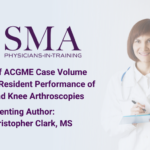Abstract | May 5, 2021
The Effect of ACGME Case Volume Minimums on Resident Performance of Shoulder and Knee Arthroscopies
Learning Objectives
- Describe the trends in the number of shoulder and knee arthroscopies performed by orthopaedic surgery residents before and after the implementation of case minimums by the ACGME.
Background/Knowledge Gap:
The purpose of this study was to examine how the implementation of Accreditation Council of Graduate Medical Education (ACGME) case minimums in 2013 has affected the number of shoulder and knee arthroscopies performed by orthopaedic surgery residents during their clinical training.
Methods/Design:
The ACGME orthopaedic surgery case log data from graduation years 2007-2019 was used to evaluate the number of shoulder and knee arthroscopies performed. The mean and median number of cases performed per resident were compared for the years prior to implementation of the ACGME case minimums (2007-2012) and after (2013-2019).
Results/Findings:
The ACGME orthopaedic surgery case minimums resulted in a significant decrease in the mean number of shoulder and knee arthroscopies performed. The mean number of shoulder arthroscopies performed in the years before and after the case minimum requirement were 109.8 and 82.0 (p = 0.025), respectively. The mean number of knee arthroscopies performed in the years before and after the case minimum requirement were 178.6 and 124.8 (p = 0.006), respectively. The mean total of all surgical cases performed in the years before and after the case minimum requirement were 2045.5 and 1699.3 (p = 0.038), respectively. Residents in the 10th percentile of cases still met the required ACGME case minimums each year.
Conclusions/Implications:
This study may demonstrate the effect of the implementation of the ACGME case minimums on the number of shoulder and knee arthroscopies performed by orthopaedic surgery residents. The implementation of case minimums by the ACGME may have resulted in decreased reporting of shoulder and knee arthroscopies performed by orthopaedic surgery residents. The ACGME should consider increasing the case minimums for shoulder and knee arthroscopies to promote accurate logging of cases.

